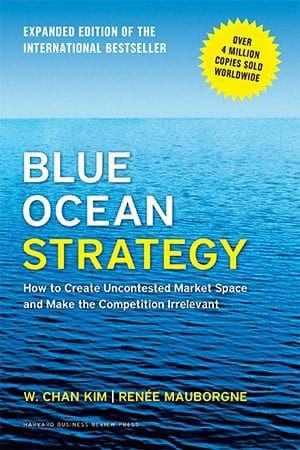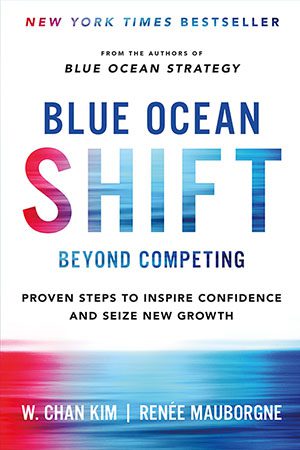Excerpts from Chan Kim & Renée Mauborgne’s Blue Ocean Strategy (2015), Blue Ocean Shift (2017), and their How Strategy Shapes Structure Harvard Business Review (September 2009) article.
What is red ocean strategy?
Red ocean strategy is all about competition. As the market space gets more crowded, companies compete fiercely for a greater share of limited demand.
Red oceans represent all the industries in existence today. This is the known market space. Blue oceans denote all the industries not in existence today. This is the unknown market space.
In the red oceans, industry boundaries are defined and accepted, and the competitive rules of the game are known. Red ocean strategy is when companies try to outperform their rivals to grab a greater share of existing demand. As the market space gets crowded, prospects for profits and growth are reduced. Products become commodities, and cutthroat competition turns the red ocean bloody.

Red ocean strategy: structure shapes strategy
When executives develop corporate strategy, they nearly always begin by analyzing the industry or environmental conditions in which they operate. They then assess the strengths and weaknesses of the players they are up against. With these industry and competitive analyses in mind, they set out to carve a distinctive strategic position where they can outperform their rivals by building a competitive advantage. To obtain such advantage, a company generally chooses either to differentiate itself from the competition for a premium price or to pursue low costs. Think Mercedes Benz.
The underlying logic here is that a company’s strategic options are bounded by the environment. In other words, structure shapes strategy.
Read next how red ocean strategy focuses on either differentiation or cost leadership.
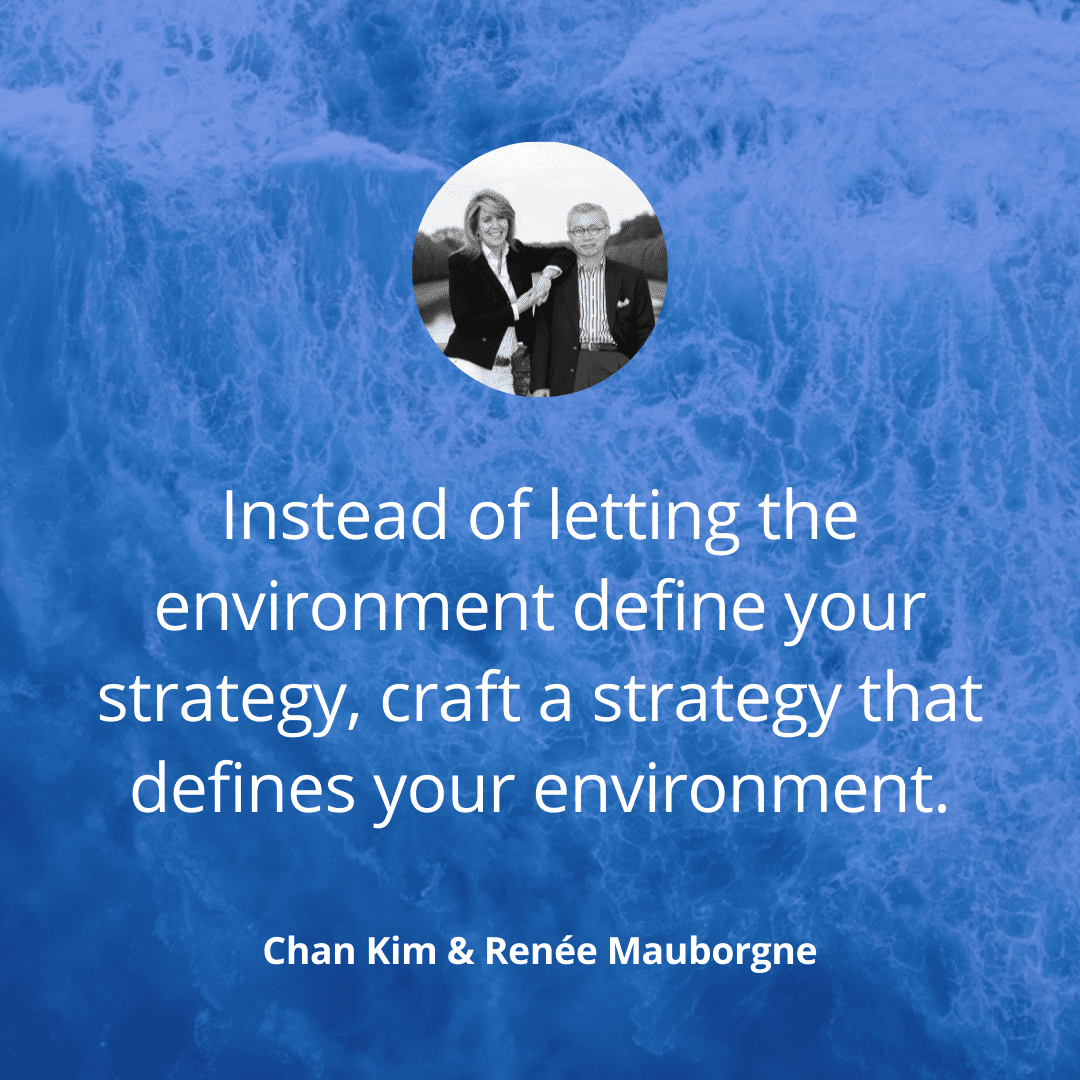
Blue ocean strategy: strategy shapes structure
On the other hand, blue ocean strategy posits that a company’s performance is not necessarily determined by an industry’s competitive environment. Blue ocean strategy, by contrast, is about breaking the value-cost trade-off to open up new market space. It is about pursuing differentiation and low cost simultaneously.
Think Casella Wine’s [yellowtail] or Comic Relief’s Red Nose Day. The blue ocean strategy framework can help companies systematically reconstruct their industries and reverse the structure-strategy sequence in their favor. In other words, strategy can shape structure.
Read next: “7 Powerful Blue Ocean Strategy Examples That Left the Competition Behind” and “5 Compelling Strategy Canvas Examples You Can Learn From“.
Red or blue: which one is for you?
In choosing which of the two is most appropriate for your organization, you need to consider environmental attractiveness, the capabilities and resources you can call on, and whether your organization has a strategic orientation for competing or for innovating. Diversified companies should be comfortable using both approaches.
Whichever type of strategy, red ocean strategy or blue ocean strategy, is chosen, success will depend on creating an aligned set of strategy propositions targeted at three different set of stakeholders: buyers, shareholders, and the people working for or with the organization.
Red ocean strategy diverges from blue ocean strategy in the nature of their proper alignment. For more on strategic alignment, read next “Strategic Alignment – The Key to Successful Business Strategy.”
Key differences between Red Ocean Strategy and Blue Ocean Strategy
Red ocean strategy is a market-competing strategy. Blue ocean strategy is a market-creating strategy.
The table below summarizes the key conceptual differences between red ocean strategy and blue ocean strategy. Learn more about red ocean strategy vs blue ocean strategy here.
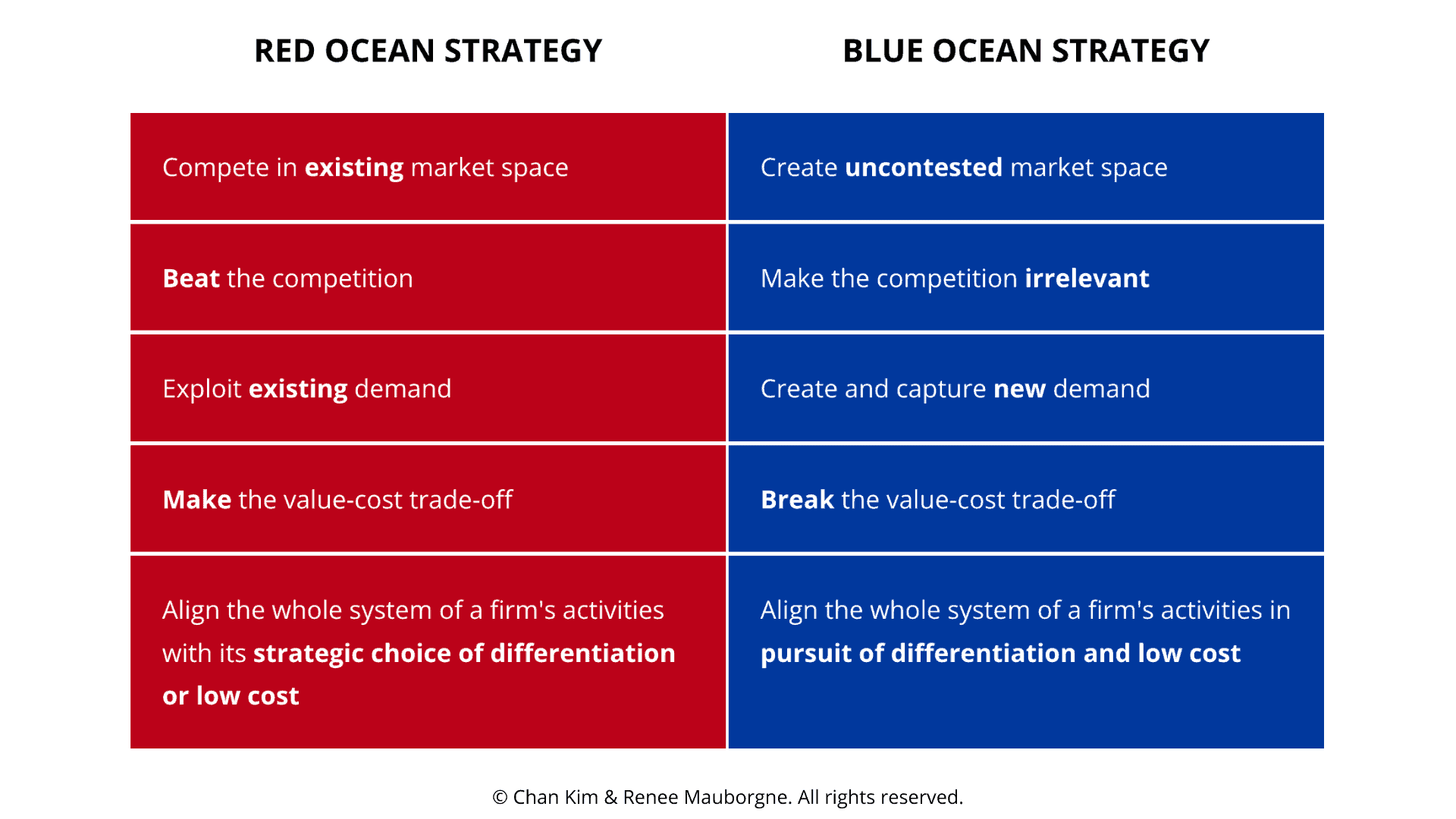
Red ocean strategy vs blue ocean strategy.

Red ocean strategy examples
Red ocean strategy exists in all industries. Think about all the major retail banks in New York, Paris, London, and Tokyo. Are there any real differences in their facades, atmosphere or even service? From a buyer’s point of view, they all seem the same. What about gas stations the world over; or law firms or management consultancies?
Let’s look at one example of red ocean strategy and blue ocean strategy in the hospitality industry. Many areas of the hospitality industry suffer from slow growth, tight profit margins, and fierce competition.
“If there ever were a red ocean,” observes Michael Levie, co-founder of CitizenM Hotels, “the hotel industry would be it. It’s redder than red.”

Red ocean strategy of hotels
Four-star hotels offer four-fifths of what five-star hotels offer. Three-star hotels offer three-quarters of what four-star hotels provide. And so on down to one-star hotels that offer roughly half of what two-star hotels offer. In other words, they all pursue red ocean strategy where they all compete on essentially the same things.
“In this industry,” says Levie, “people think they’ve innovated if they change the paint color on the walls or switch the type of chocolate on the pillow.”
Against this backdrop, Rattan Chadha and Michael Levie, co-founders of CitizenM – both new entrants to the hotel industry – wanted to create a blue ocean with a new kind of hotel chain. One that would capture the growing mass of frequent travelers – what they call “mobile citizens” – whether traveling for business or pleasure.
Citizen M hotel is an example of a blue ocean strategy in a fiercely competitive market. Read how instead of pursuing a red ocean strategy, CitizenM created a blue ocean market space in the red ocean industry. Read next: “Blue Ocean Strategy in the Hospitality Industry. How CitizenM created new market space in an overcrowded industry.”
Check out CitizenM’s strategy canvas to see how their strategy stands out from red ocean strategy of other hotels.

Charities: a red ocean strategy in the fundraising industry
Think about red ocean strategies of the major charities around the world. Traditional charities use feelings of guilt and pity to pull in donations, focus on securing and recognizing large gifts from high-income donors, and solicit funds year-round.
Comic Relief, by contrast, uses a breakthrough approach, Red Nose Day, that combines a day of outrageous community “fun”raising with a star-studded comedy telethon, Red Nose Night. Participants need only buy a red nose for £1 to raise money by doing silly antics that friends sponsor. Even the tiniest donation is valued and recognized.
Comic Relief creates this unique experience only every two years to prevent people from being bored or hassled. Its value proposition allows donors to make a huge difference while having a great time, at low cost.
Learn how Comic Relief achieved strategic alignment and stood apart from the competition.

Red ocean strategy example: the US wine industry before [yellowtail]
Another example comes from the US wine industry. This industry has always been highly competitive, and wine manufacturers have systematically competed along the same set of factors for centuries. So for strategists, the question was how to break out of this red ocean of bloody competition and open up a blue ocean of uncontested market space.
One answer was given by Australian winemakers, Casella Wines, who entered the US market in 2001. They re-oriented their strategic focus from competitors to alternatives and from customers to noncustomers. They looked at the alternatives of beer and ready-to-drink cocktails, and competed on new factors such as ‘easy drinking’ and ‘fun and adventure’. As a result of this strategic shift, their wine, [yellow tail], became the number-one selling wine in a 750-ml bottle sold in the US in 2005.
To see how [yellowtail]’s value curve stands out from the red ocean of competition, check out “5 Compelling Strategy Canvas Examples You Can Learn From“.
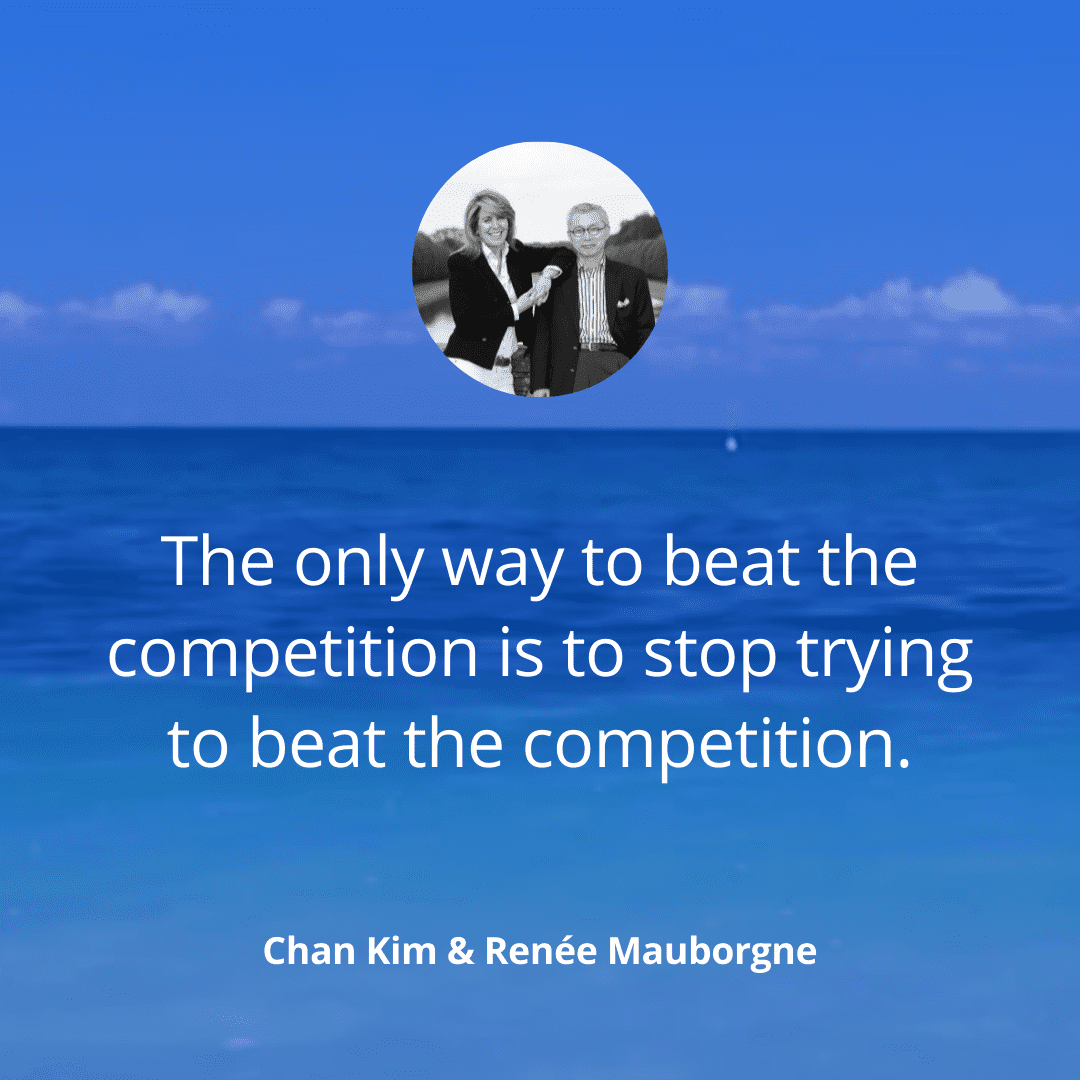
Or think about circus industry and its major players Ringling Bros. and Barnum & Bailey. They were a classic example of red ocean strategy, trying to outcompete each other for the limited demand. When Cirque du Soleil entered the stage, it did not win by taking customers from the already shrinking circus industry, which historically catered to children.
It did not compete with Ringlin Bros. and Barnum & Bailey. It appealed to a whole new group of customers: adults and corporate clients prepared to pay a price several times as great as traditional circuses for an unprecedented entertainment experience.
Cirque du Soleil succeeded because it realized that to win in the future, companies must stop competing with each other.
To learn why Cirque du Soleil is the classic example of blue ocean strategy and what are six other powerful blue ocean examples you might not have heard off, read 7 Powerful Blue Ocean Strategy Examples that Left the Competition Behind.
The case study of Cirque du Soleil is analyzed in depth in the Blue Ocean Strategy book. Make sure to check it out here.
And read: “Six Red Ocean Traps You Should Know“. Check if you have these mental models that undermine market-creating strategies.
Why you need to move away from red ocean strategy
In the aftermath of the global pandemic, managers around the world are bracing for new challenges ahead. Many of them wonder whether the strategic approaches that proved to be successful in the past will still apply to changed business realities in a post-pandemic world. Indeed, many changes have occurred – supply chain restructuring, altered customer preferences, and changed government regulations, to name a few.
But one fundamental reality will endure and intensify. Companies will face a heightened degree of competition as customer demand is depressed due to a reduction of income, persistent unemployment, and looming uncertainties. While everyone desires a V-shaped economic rebound, it will be difficult for companies to overcome the current financial distress once they are locked into a hopeless game of dividing a shrinking pie. More than ever, firms need to create blue oceans of new demand in order to generate revenue, profit, and new growth. It is far more urgent for managers to think like a blue ocean strategist.
For more information on the topic, read “How to be a Blue Ocean Strategist in a Post-Pandemic World.“
It will always be important to swim successfully in the red ocean by outcompeting rivals. Red oceans will always matter and will always be a fact of business life. But with supply exceeding demand in more industries, competing for a share of contracting markets, while necessary, will not be sufficient to sustain high performance.
Companies need to go beyond competing. To size new profit and growth opportunities, they also need to create blue oceans. A better balance must be struck across red ocean and blue ocean initiatives.
The resources below will help you make a shift from red ocean of competition to blue ocean of uncontested market space.
How to shift from red ocean to blue ocean
To successfully shift from red oceans of bloody competition to blue oceans of new market space depends on three key components:
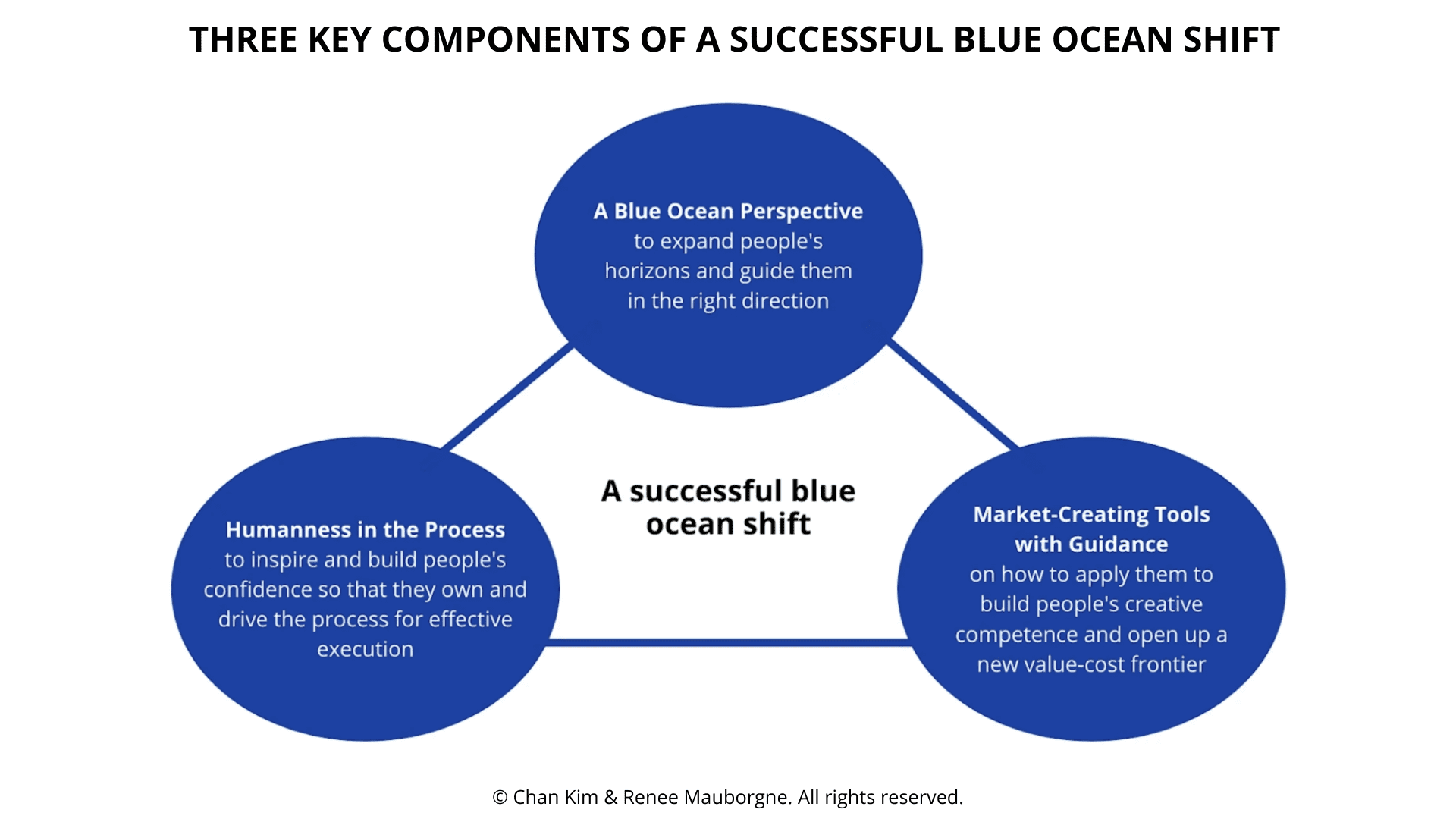
1. A Blue Ocean Perspective
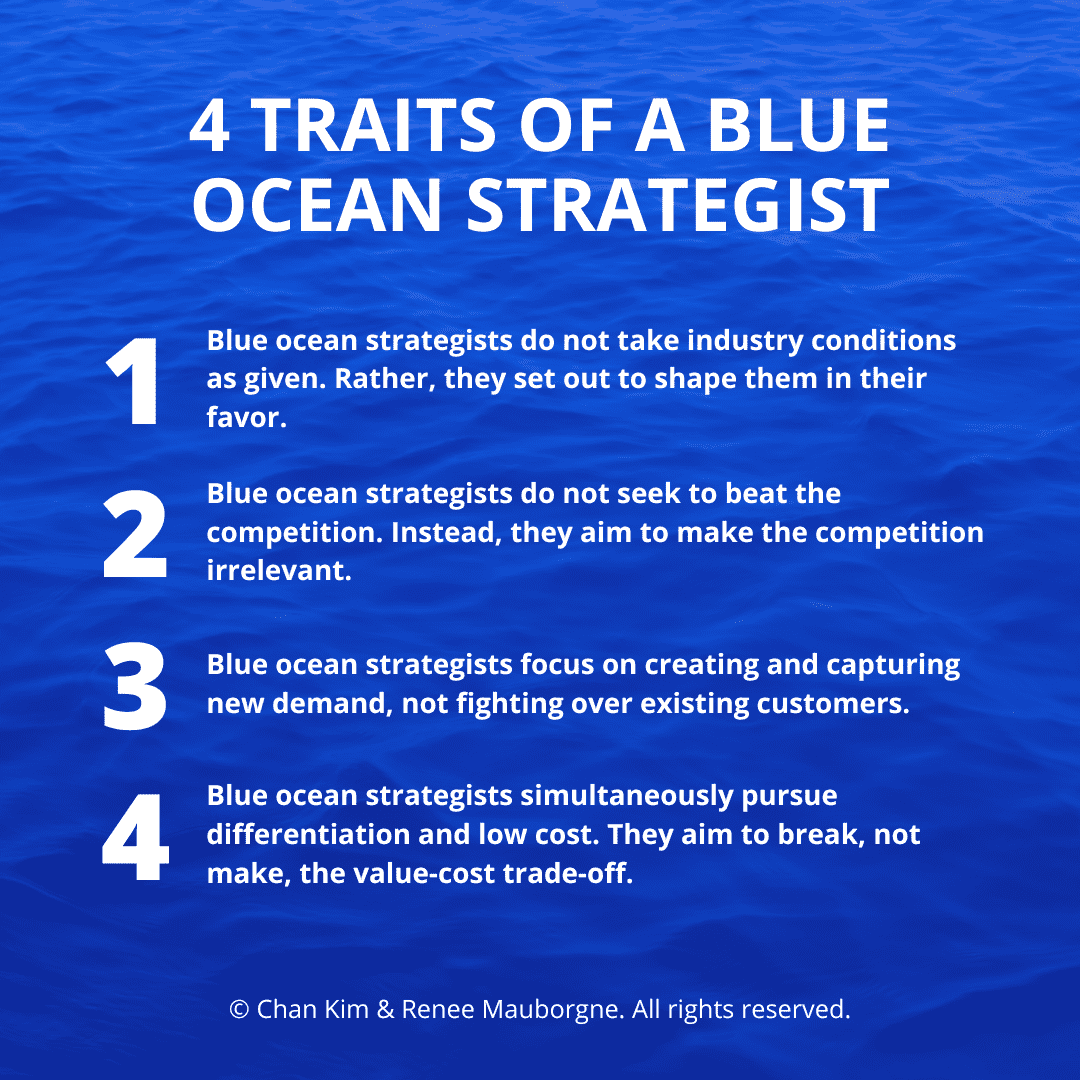
You need to adopt the mindset of a blue ocean strategist and blue ocean perspective, so that you expand your horizons and shift your understanding of where opportunity resides.
Read next: “Do You Have a Mind of Blue Ocean Strategist?“
2. Market-creating tools with Guidance
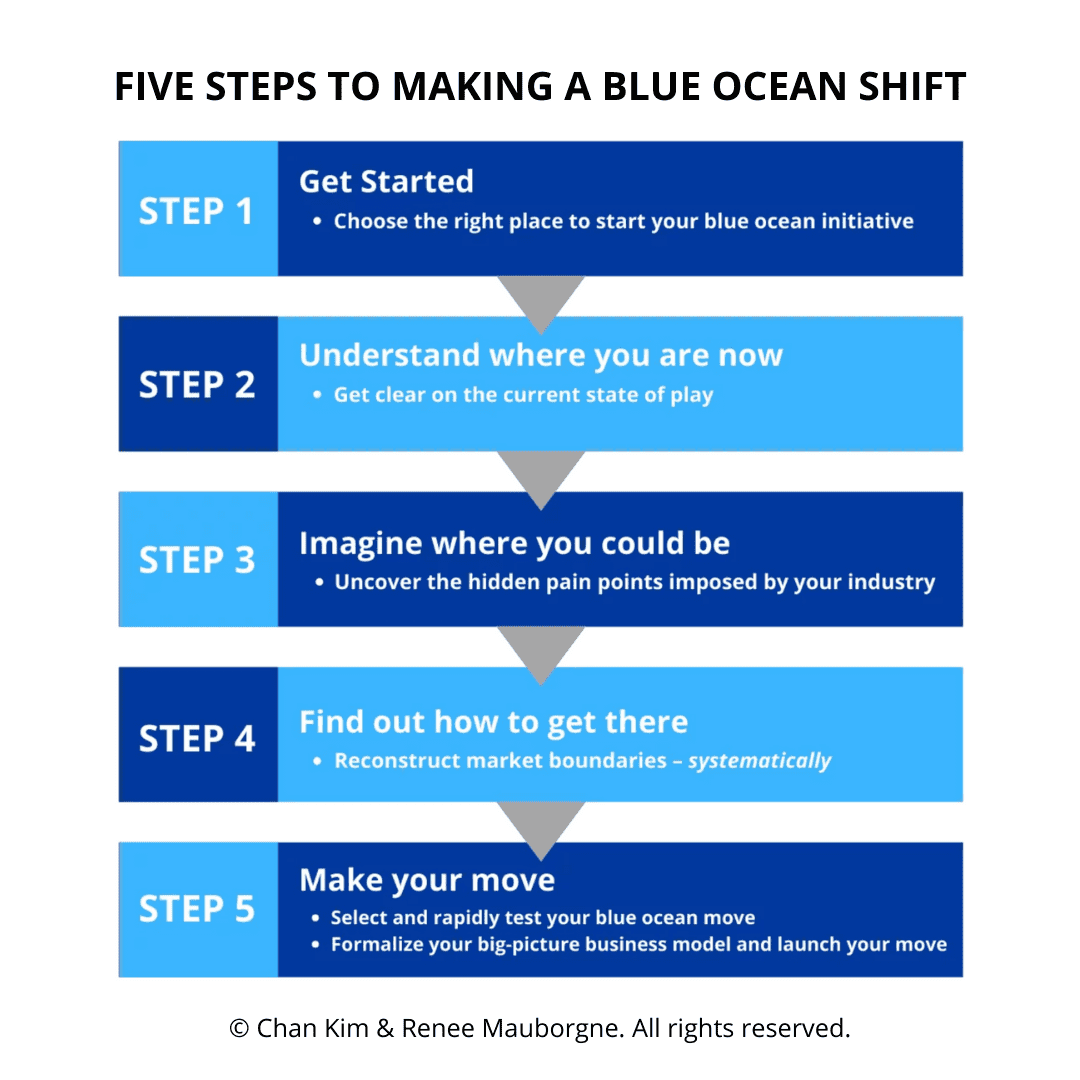
The second component is having practical tools for market creation with proper guidance on how to apply them to translate a blue ocean perspective into a commercially compelling new offering that creates new market space.
Read next: “Five Steps to Making a Blue Ocean Shift.“
3. Humanness in the Process
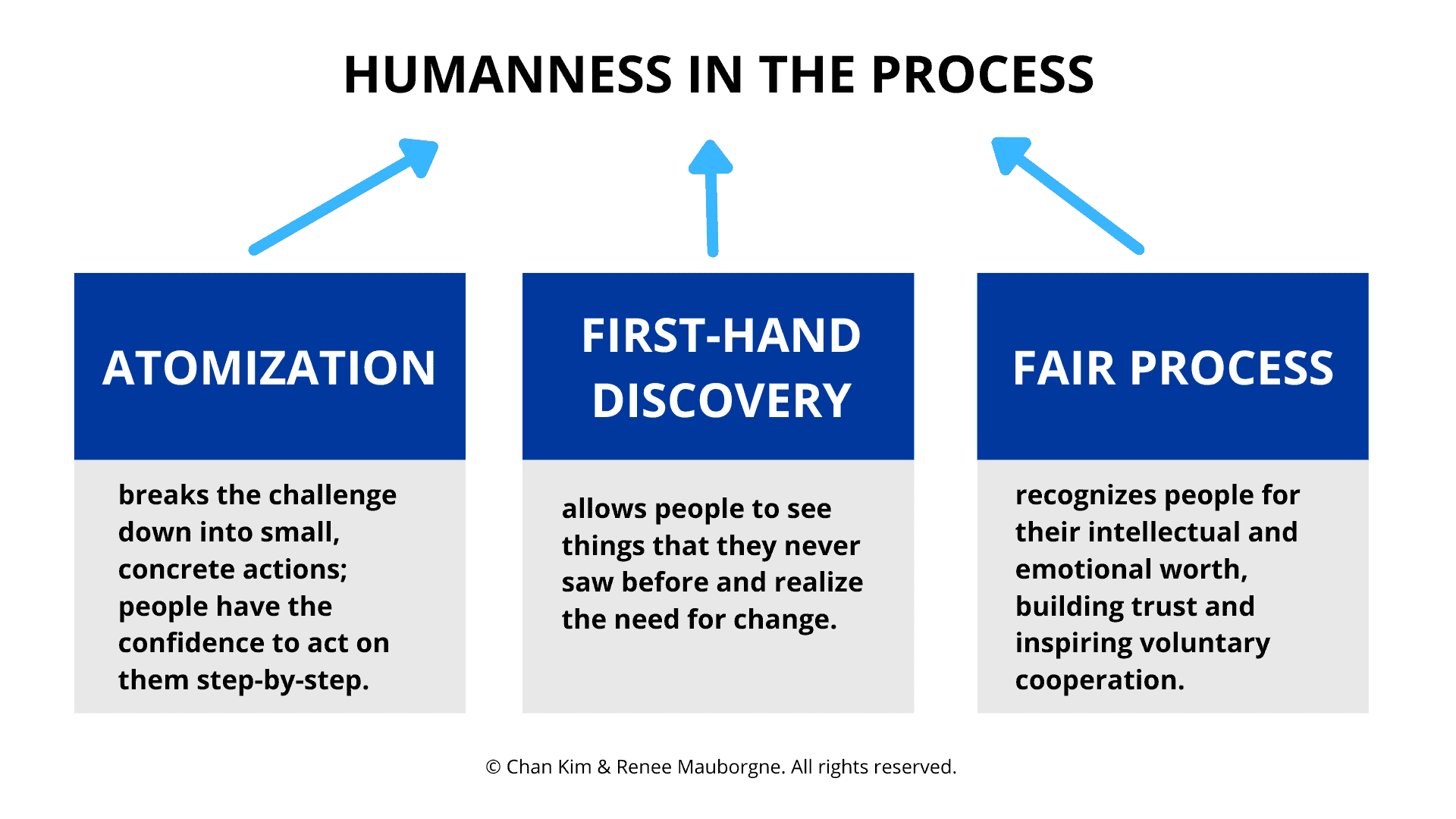
The third component is having a humanistic process, “humanness,” which inspires and builds people’s confidence to own and drive the process for effective execution.
Read next: “Why You Need Humanness to Make a Blue Ocean Shift.”
Are you ready to leave the competition behind?
Be sure to check out Blue Ocean books for detailed guidance on how to move from red ocean strategy to blue ocean strategy. The books will walk you through how to apply blue ocean strategy tools and frameworks to your situation, explain how to interpret the results, highlight the potential pitfalls, and discuss how to overcome those pitfalls to ensure your success. Check them out!


